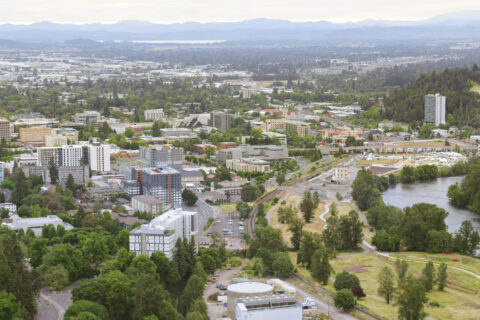This case study is part of the Reimagining Public Safety Impact Updates Resource, which highlights successful programs in cities, towns and villages across the country. View the Reimagining Public Safety Initiative to learn more about NLC’s work in creating safe, equitable communities for all. This is one of several municipalities illustrating the Community Response Model, which relies on trained, unarmed civilians to respond to crises and provide behavioral health services. This Case Study was added in 2025.
Olympia, WA (pop. 55,605): Crisis Response Unit (CRU)
Olympia’s Crisis Response Unit (CRU), launched in April 2019, is a community response program providing confidential and voluntary crisis response assistance. CRU responds to community members experiencing distress, whether mental health or substance use crises, needs related to poverty or housing, or other calls for service. CRU provides services to these community members, including conflict resolution, housing referrals, resource connections, first aid, and transportation. By responding to behavioral health crises, the CRU not only eases the burden on police but also builds relationships with community members. CRU also works proactively to connect individuals with mental health services, diverting people from arrest.
“CRU’s goal is to address needs that might spiral and cause later contacts with police.”
The CRU is housed within Olympia’s Police Department and, as of June 2024, CRU is made up of 12 non-commissioned, non-armed first responders. Olympia’s CRU has two teams. The mobile unit operates seven days a week from 6:20 AM to 3 PM and responds to calls triaged through Thurston County 911 Communications and Olympia police dispatch. The downtown walking unit was implemented in January 2024, consisting of two on-foot members assigned to Olympia’s downtown core. The walking unit emphasizes visibility and accessibility for community members in this area, operating from 11 AM through 7 PM Tuesday through Saturday.
In 2023, the mobile CRU team responded to 3,212 calls for service (PDF); CRU leaders projected this number would increase by 32 percent the following year, to about 4,600 responses in 2024. After responding, CRU transports hundreds of individuals to services or shelter and provides referrals to community and city partners. The CRU walking unit independently responded to 934 calls for service within the first six months of operation (January to June 2024). Olympia Police Deputy Chief Shelby Parker explained the walking unit’s call volume demonstrates the high level of activity in this area, stating, “The data showed the impact of having dedicated CRU members accessible full-time in the downtown core.”
The Olympia Police Department’s 2025-2030 strategic plan (PDF) states that the CRU program is popular among community members who know about the program, but there is an opportunity to share more information about the program with the larger community.
Housed within Olympia’s Police Department, Olympia’s CRU was loosely modeled after Eugene, Oregon’s CAHOOTS community response program. The CRU is funded by revenue from Olympia’s 2017 public safety levy. In 2023 (PDF), the budget for CRU was approximately $1.4 million, with the bulk of costs allocated toward staffing.
Some key performance metrics collected include:
- Number of responses to calls for service (for mobile unit and downtown walking unit)
- Number of transports to services or shelter
- Number of referrals to community and city partners
Acknowledgements for contributions and review from Ren Emerson-Beckman, Outreach Services Coordinator
View the Reimagining Public Safety Impact Update
Learn more about what different cities have done to support public safety, including qualitative and quantitative measures highlighting the impact of community responder models, group violence interventions, hospital-based violence interventions and community violence interventions.




